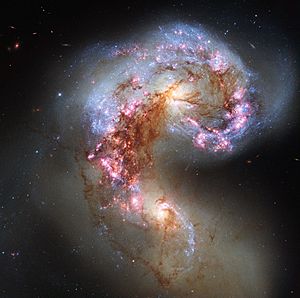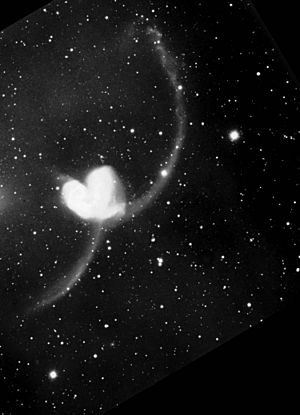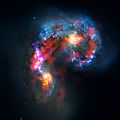Antennae galaxies facts for kids
Quick facts for kids Antennae galaxies |
|
|---|---|

NGC 4038 (left) and NGC 4039 (right)
|
|
| Observation data (J2000 epoch) | |
| Constellation | Corvus |
| Right ascension | 12h 01m 53.0s / 12h 01m 53.6s |
| Declination | -18° 52′ 10″ / -18° 53′ 11″ |
| Redshift | 1642 ± 12 / 1641 ± 9 km/s |
| Distance | 45 Mly / 65 Mly |
| Type | SB(s)m pec / SA(s)m pec |
| Apparent dimensions (V) | 5′.2 × 3′.1 / 3′.1 × 1′.6 |
| Apparent magnitude (V) | 11.2 / 11.1 |
| Notable features | Interacting galaxies |
| Other designations | |
| Ringtail Galaxy, NGC 4038 / 4039, PGC 37967 / 37969, Arp 244, Caldwell 60/61 |
|
| See also: Galaxy, List of galaxies | |
The Antennae galaxies (NGC 4038/NGC 4039) are two colliding galaxies. They are in the constellation Corvus. The process takes hundreds of millions of years, maybe even a billion years.
The collision, with its clouds of gas, dust and magnetic fields, causes extremely rapid star formation. This is their starburst phase, and might last a few hundred million years. They were discovered by William Herschel in 1785.
They are in the NGC 4038 group with five other galaxies. Before The Collision, NGC 4038 was a barred spiral galaxy and NGC 4039 was a spiral galaxy. These two galaxies are known as the Antennae galaxies because they have two long tails of stars, gas and dust ejected from the galaxies as a result of tidal force in the collision that look like an insect’s antennae. The nuclei of the two galaxies are joining to become one giant galaxy, sometime in the future to form an Elliptical galaxy.
These interacting galaxies are nearer and less remote to the Milky Way than previously thought—at 45 million light-years instead of 65 million light-years.
Images for kids
-
Visible light Hubble image (blue) showing newly formed young stars overlaid with a radio image from the Atacama Large Millimeter Array showing the clouds of dense cold gas from which new stars form (red, pink and yellow)
See also
 In Spanish: Galaxias Antennae para niños
In Spanish: Galaxias Antennae para niños




